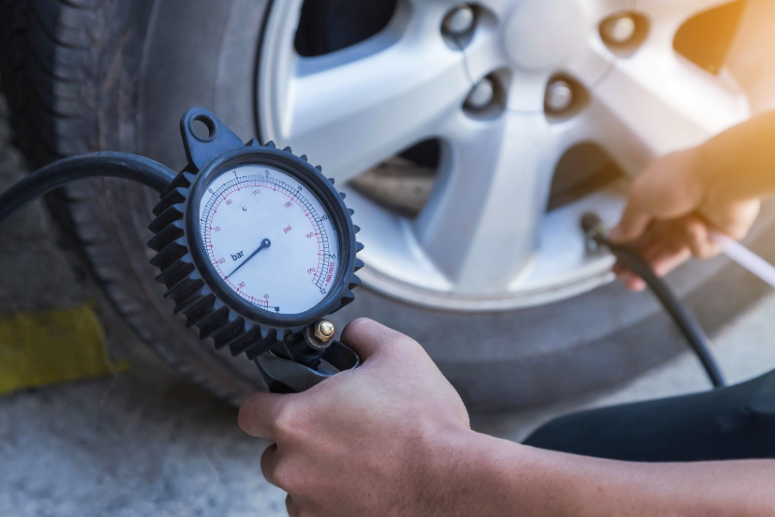Easy Steps to Check Your Tire Pressure
Your tires are the silent workhorses of your car. They’re the only point of contact with the road, influencing everything from handling and fuel efficiency to safety and longevity. Proper tire pressure is crucial for optimal performance, yet it’s often a neglected aspect of car maintenance. This blog delves deeper than just how to use a pressure gauge, exploring the often-overlooked factors affecting tire pressure and offering tips for maximizing your tire’s potential.
Why Proper Tire Pressure Matters?
Most car manufacturers recommend a specific tire pressure rating, typically found on a sticker inside the driver’s door jamb. Maintaining this pressure ensures optimal fuel efficiency, according to the U.S. Department of Energy (DoE). They report that underinflated tires can decrease fuel economy by up to 3.3%, translating to wasted money at the pump.
But proper pressure goes beyond fuel savings. The National Highway Traffic Safety Administration (NHTSA) emphasizes the safety implications .Underinflated tires can lead to increased stopping distances, reduced handling, and blowouts at highway speeds. A study by the Rubber Manufacturers Association (RMA) found that improperly inflated tires are a contributing factor in approximately 33% of fatal passenger car crashes .
The Hidden Culprits Affecting Tire Pressure
While most blogs focus on using a pressure gauge which we’ll cover shortly, there are other factors that can significantly impact your tire pressure:
Temperature: Air is a gas, and gases expand with heat. On a hot day, your tire pressure will naturally increase. Conversely, on a cold morning, the pressure will drop. The DoE recommends checking your tire pressure when the tires are cold, meaning they haven’t been driven for at least three hours
Altitude: As you climb in altitude, the air pressure around you decreases. This can also lead to a decrease in your tire pressure. If you’re planning a mountain trip, it’s wise to check and adjust your tire pressure accordingly.
Load: The weight your car is carrying affects tire pressure. Heavier loads require slightly higher inflation pressures to maintain proper handling and avoid overloading the tires. Refer to your car’s owner’s manual for specific recommendations when carrying a full load of passengers or cargo.
Checking and Adjusting Tire Pressure
Now that we’ve explored the factors affecting pressure, let’s get down to the practical steps. Here’s what you’ll need:
A reliable tire pressure gauge: There are two main types: digital and analog (dial). Digital gauges are often easier to read, but a good quality analog gauge can be just as effective.
Valve stem caps: These small caps help keep dirt and debris out of the valve stem, which can affect pressure readings.
Steps to Check and Adjust Tire Pressure:
- Park your car on a level surface and ensure the tires are cold.
- Locate the valve stem on each tire. It’s the short rubber protrusion near the rim.
- Unscrew the valve stem cap and press the tire pressure gauge firmly onto the valve stem. You should hear a short hiss of air escaping.
- Read the pressure gauge. For digital gauges, the number will be displayed on the screen. For analog gauges, a bar will pop out and indicate the pressure on a scale.
- Compare the reading to the recommended pressure for your car. This information can be found on a sticker inside the driver’s door jamb or in your owner’s manual.
Uh oh, low tire pressure? Don’t sweat it! If you find your tire pressure is low and you’re not comfortable adjusting it yourself, Wheels Up Towing is here to help. We offer 24/7 roadside assistance, including flat tire changes. Contact us and we’ll get you back on the road safely and quickly.
Pro Tips for Maintaining Optimal Tire Pressure:
- Check your tire pressure regularly. A good rule of thumb is to do it once a month, especially before long trips.
- Invest in a portable air compressor. This will allow you to adjust your tire pressure on the go without relying on gas station pumps.
- Consider a Tire Pressure Monitoring System (TPMS). These systems can alert you when a tire’s pressure is low, providing an extra layer of safety and convenience.
Understanding TPMS and Nitrogen Inflation
Many modern vehicles come equipped with TPMS. These systems use sensors in each…
This revision integrates Wheels Up Towing’s services by offering roadside assistance for situations where someone discovers low tire pressure and doesn’t feel comfortable adjusting it themselves.

